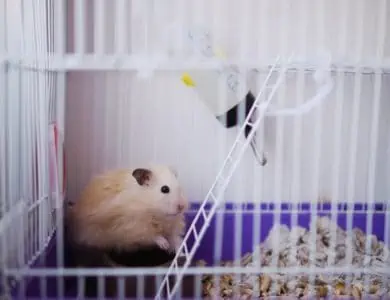If you have a pet hamster it doesn’t matter if it’s a Dwarf or Syrian hamster. You want to take good care of your pet so it lives a long and healthy life. This means that you’ll need to clean the cage regularly.
Not only does a dirty cage stink, but it can cause health problems in your pet. To prevent this, follow our easy guide on how to clean a hamster cage.
Key Takeaways
- Clean hamster cages daily, with deep cleaning once a week for a healthy environment.
- Use bleach solution, white vinegar, or dish soap for cleaning hamster cages.
- During cleaning, put hamsters in a small pet carrier or exercise ball.
- Hamsters groom themselves, so baths are not necessary; spot clean if needed.
How Often to Clean a Hamster Cage
A hamster cage should be spot cleaned daily, especially if you have a young hamster with a fast working digestive system. Weekly cleaning includes changing the bedding and cleaning the cage.
However, if you have more than one hamster, you will likely need to clean the cage 2 or 3 times a week. You can tell if a hamster cage needs to be cleaned when it begins to smell like ammonia or the bedding is wetter than normal.
What Can I Use to Clean My Hamster’s Cage?
There are several cleaning products you can use to clean your hamster’s cage. The first DIY option is to put 2 tablespoons of bleach in a 16oz spray bottle filled with water.
You can use undiluted white vinegar as a cleaner, or a disinfectant from the pet store. A third option is to use regular dish soap to clean your hamster’s cage.
How to Clean a Hamster Cage
A hamster cage needs to be spot cleaned daily and receive a deep cleaning at least once a week.
Spot Cleaning
Spot cleaning your hamster’s cage will help to keep your hamster healthy. It’s an easy but needed task to complete each day.
- Time: 10 minutes
- Difficulty: Beginner
What You’ll Need
- Bedding
- Gloves or scoop
- Dish soap
- Food
- Water
1. Remove Wet & Soiled Bedding
Wear gloves or use an animal scoop so you don’t get any germs or bacteria on your hands. Remove all the poop you can see from your hamster’s cage. Then remove all wet and soiled bedding.
Be sure to check the areas where your hamster tends to use the bathroom, also called potty spots.
2. Replace Bedding
Replace any bedding that you removed with fresh bedding.
3. Replace Food and Water
Remove the food and water bowls, and discard the old food and water. Wash the bowls with dish soap and warm water, before rinsing them thoroughly. Then put fresh food and water into the containers.
You will need to do this daily to prevent bacteria and germs from building up in your hamster’s cage making it sick.
4. Examine Cage
Check your hamster’s cage. You’re looking to see if the walls are smudged or dirty. Also, check to see if there’s an ammonia smell or unusually wet bedding.
These are signs that your hamster’s cage will need a deep cleaning instead of a spot cleaning.
Deep Cleaning
You will need to deep clean your hamster’s cage once a week. Try to clean on the same day each week as a routine is less stressful for your hamster. This will also help you remember to do your weekly clean without trying to figure out when last you did it. You will also need to deep clean if you smell ammonia or see unusually wet bedding.
The safest way is to use specific cloths or sponges that are designated for cleaning your hamster’s cage. This will help prevent cross-contamination.
- Time: 30 minutes
- Difficulty: Beginner
What You’ll Need
- Microfiber cloths
- Sponge (optional)
- Toothbrush
- White vinegar or mild dish soap
- New bedding – will keep ⅓ of old bedding so hamster is not stressed
1. Remove Hamster
The first step is to put your hamster in their small pet carrier or their exercise ball. If you choose to place your hamster in the ball, make sure you don’t leave them there for more than 30 minutes.
Wash your hands before and after handling your hamster. This will prevent you from spreading germs to your hamster and your hamster from spreading germs to you. Use regular unscented hand soap.
2. Remove Contents
Remove everything from your hamster’s cage. This includes water and food bowls, toys, exercise equipment, and anything hanging on the sides of the cage.
3. Discard Old Bedding
Discard most of the old bedding. You’ll want to keep a small amount, about ⅓, of the old bedding to mix with the new bedding. This will reduce your hamster’s stress.
4. Wash Objects in Cage
Wash everything that was in the cage in soap and water. Use a microfiber cloth to get into the corners and crevices. You can also wash the objects in a disinfectant solution or even soak the objects as needed.
Make sure that you clean everything thoroughly and rinse it with fresh water when you’re done.
5. Clean Cage
Now clean every part of the cage with your cleaning solution or dish soap and water. You may need to scrape any stuck bedding to loosen and remove it from the cage. You can also soak problem areas to make the bedding easier to remove.
If your cage is wire mesh, make sure that you clean each bar. An aquarium-style cage will need every wall or surface cleaned. Use a toothbrush to help get into the small areas of the cage.
6. Rinse Everything
Rinse everything thoroughly. This will help to protect your hamster against any chemicals or smells in the cleaning solution.
7. Dry Everything
After everything is rinsed thoroughly, dry the cage and accessories. You can use a clean cloth to dry the cage or put it in the sun. The sun will also help to disinfect the cage.
Make sure that the cage is completely dry before moving on to step 8.
8. Mix Bedding
Mix the small amount of old bedding with the new bedding. This will help to reassure your hamster and reduce the stress of having the cage cleaned as it will still have a familiar smell.
9. Reassemble
Reassemble the cage. Put the bedding into the cage first. Then place the exercise equipment, toys, along with food and water bowls back in the cage.
10. Replace Hamster
Put your hamster back in the cage. Give your hamster several hours to settle back into its home before you handle your hamster.
After One Dies
After a hamster dies, you will need to sanitize the cage to ensure that your other hamsters will not get sick.
- Time: 1-2 hours
- Difficulty: Beginner
What You’ll Need
- White vinegar
- Deodorizer spray
- Toothbrush
- Abrasive cloths
1. Remove Hamster
Remove your hamster and put him into a safe spot such as a small animal carrier. It will take longer than a weekly deep clean to clean the cage.
2. Empty Cage
Empty the cage of all accessories. Throw away all the bedding that was in the cage. Do not keep any to mix in with the new bedding as it may be contaminated.
3. Make Vinegar Solution
Make a vinegar solution of 1 part vinegar and 2 parts water. Mix and put the solution into a spray bottle.
4. Scrub
Scrub everything with abrasive cloth and the vinegar solution. You will be rubbing away all the dirt, soil, and germs. Use a toothbrush to get into tight corners.
Spend some time making sure that you’ve scrubbed every part of the cage to prevent your hamster from becoming sick.
Allow the cage to sit for 2-3 hours to give the vinegar time to disinfect the cage.
5. Wash and Rinse Cage
Wash the cage with dish soap and water to remove the vinegar from the cage. When you finish washing the cage, rinse it thoroughly. If you can, put the cage in the sun for an afternoon. This will help to disinfect and dry the cage.
6. Deodorize Cage
Use a deodorizer spray to remove the smell of the dead hamster. You can pick up the spray at the pet store to be sure that it’s safe for your pet.
You can also sprinkle baking soda on the bottom of the cage. Wait 30 minutes and then wipe up the baking soda.
7. Clean Accessories
Soak all accessories in vinegar for a couple of hours. Then wash the accessories with dish soap and water before rinsing them thoroughly. This will ensure that the food and water bowls, toys, and exercise equipment is disinfected.
Consider replacing all chew toys.
Where to Put Hamster When Cleaning Cage
When cleaning a hamster cage, put your hamster in the exercise ball, an extra cage, or a small pet carrier.
Hamster Grooming Tips
There are a few things you can do to help your hamster stay clean.
- Clean the food and water bowls daily.
- Spot clean your hamster cage every day.
- Use a soft, unused toothbrush to groom long-haired hamsters.
- Use scissors to remove any chunks such as gum or glue in the hair.
Do Hamsters Clean Themselves?
Yes, hamsters will clean themselves so you don’t need to bathe them.
Do Hamsters Need a Sand Bath?
Hamsters usually clean themselves so they don’t need a sand bath. However, most hamsters do enjoy a sand bath. However, it’s not recommended to give your hamster a dust bath as they can give a hamster respiratory problems.
How to Keep a Hamster Cage From Smelling
You can keep a hamster cage from smelling by sprinkling baking soda on the bottom of the cage after you’ve cleaned it. Let it sit for a few minutes before wiping the baking soda up.
Another option is to wet a sponge with vinegar and wipe the cage. Be sure to rinse the cage afterward to remove the smell of vinegar.
Be sure to keep up with the regular cleanings as this is the best way to prevent stinks. Also, ensure that your hamster cage has 2 inches of filling or bedding in.
How Often to Change the Hamster Bedding
Remove all soiled bedding daily and replace it with new bedding. You’ll also change your hamster’s bedding weekly by removing the old bedding and replacing it with fresh ones. It is advised to keep a small amount of the old bedding to mix in with the new bedding so you don’t stress your hamster.












